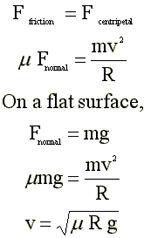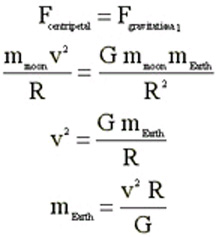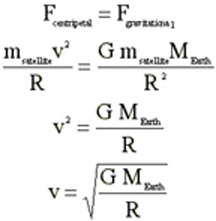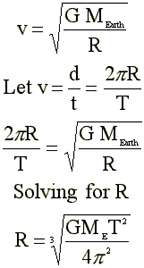Consider
an object moving now with uniform speed in a straight line, say
in a direction left to right. From Newton's first law, we can
conclude that Fnet acting on the object is zero.To make the object
speed up, one would apply some additional force pointing right.
To cause the object to slow down, the force should be applied
to the left (until the object stops anyway). But what will happen
if the force is applied to the object at a right angle to its
original path? It will neither speed up nor slow down, but rather
will change direction. If the force changes its direction so
the it always is at right angles to the path of the object, the
resulting path will be a circle with the force pointing toward
the center of the circle. If the force is constant in magnitude,
we call the result uniform circular motion. Thus when we see
an object moving is a circular path, we can look to the center
of the circle to find the source(s) of the force causing this
motion. When Newton considered the path of the moon around the
Earth or the paths of the planets around the sun, he was compelled
to find some new force holding everything together.
The force(s) add up to Fnet which in
this case is called a centripetal force, so named from the Latin roots meaning center-seeking.
The acceleration also points toward the center of the circle
and takes on the form ac
= v2/R, where R is the radius
of the path and v is the speed of the object in question. Thus
we consider the motion of an object moving in a circular path
at constant speed but is still accelerating. Go back to definitions;
1) acceleration is a change in velocity during some time interval;
2) velocity, because it is a vector quantity, has a magnitude
and a direction; therefore
a change in direction means the velocity has changed; 3) in earlier circumstances acceleration meant
only changes in magnitude; now it can apply to changes in direction.
The word centripetal should not be confused with centrifugal
(from the Latin for center-fleeing). Perhaps you have been in
an automobile that has rounded a curve slightly too fast. It
would appear that your body is flung out away from the center
of the circle. In fact, what is happening is that your body,
perhaps not firmly ensconced on the car seat, travels with uniform
speed in a straight line, while the car slides under you to negotiate
the turn.
A Ball at
the End of a String
Consider a ball attached to one end of a string;
the other end of the string is fixed in place. [Draw a picture.]
When the object is at rest, analysis of the ball shows two forces
acting on the object--Tension (which points up) and the force
of gravity (which points down). T - mg = Fnet = 0. So T = mg.
No big deal.
Now we hold
the string horizontally so that the ball is at 9 o'clock. When
released, the ball starts from rest and accelerates downward
along an arced path. [Draw another picture.] What is the tension
on the string now?
At six o'clock T - mg = Fnet = mv^2/R. So T = mg + mv^2/R. When
v = 0, this equation reduces to T = mg , as suspwcted. We will
soon see in the energy unit that the ball released at 9 o'clock
reaches 6 o'clock with v = sq rt [2gL]. Substituting this value
for v in the preceding sentence, and T = 3 mg. Can you do the
math. (What implications does this larger force have on Tarzan
as he swings through the jungle.)
If T = 0 when
the string is at 9 o'clock and T = 3 mg at 6 o'clock. What is
it in between? Careful analysis shows that, for intermediate
places along the way, T = mg cos q, where q is the angle the
string makes with the vertical. If T = mg cos q, what is T at
6 , 7, 8, & 9 o'clock
CARS & FRICTION
 |
In most situations where
cars attempt to negotiate turns on the highway, friction is the
agent causing the car to move out of the straight line path and
into the curve.
The bottom line at left shows
some of the consideration given to this matter by civil engineers.
They will determine what should be the uppermost legal speed
on the curve (and add some margin of safety). They will then
check to see how large a radius the project can handle. In most
of Maine's interstate highway system, land is not an issue and
curve radii are very large. . In tight areas, the engineer could
also tell the sand and gravel people how gritty to deliver the
pavement in order to increase the coefficient of friction
For a given curve, if the
frictional force is greater than the centripetal force needed,
the car makes the turn easily. But if the car is traveling too
fast, frictional force is maxed out even under favorable conditions
and the curve may prove treacherous. Things get worse if u is
reduced by rain. One often sees a sign that reads "Slippery
when wet" for that reason.
|
DETERMINING THE MASS OF THE EARTH (&
sun & planets)
 |
Archimedes said "Give
me a place to stand and I will move the Earth."Did he know
how big a load he was attempting to move? No, he did not. The
calculations at left show that we can calculate the mass of the
Earth by observing the motion of the moon around the Earth.Is
the speed of the moon, determined by v = D/t. D = 2 pi R where
R is the Earth-moon distance (known to ancients) and t = lunar
period (also known to ancients). The missing piece was supplied
by Henry Cavendish who determined G in 1799.
This reasoning does not apply
to the Earth only. We can determine the mass of any planet that
has satellites by applying these rules. The mass of Mercury and
Venus are determined by the amount of deviation from its assigned
path experienced by the Earth when the planets are close by.
Finally, we can determine
the mass of the sun by substituting the speed of a planet and
the radius of its orbit
|
DETERMINING THE ORBITAL VELOCITY OF A
SATELLITE
 |
Let's now calculate the orbital
speed of a satellite placed in orbit around the Earth. .Let's
try for a circular orbit where the satellite will be held in
place by gravity. How can we do this? The path is not a straight
line; it's a circle. Something at the center is acting on the
satellite.
Calculate v when
G = 6.67 x 10^-11 N m^2/s^2
M = 5.98 x 10^24 kg
R = 6.38 x 10^6 m
|
PLACEMENT OF A SATELLITE INTO GEOSYNCHRONOUS
ORBIT
 |
The answer to the question in
the previous paragraph is v = 7906 m/s = 17, 686 mi/hr. That
means that the satellite orbits the Earth once every 85 minutes.
If the device is a communication satellite, it is only in a position
favorable for broadcast about 15 minutes per orbit. Telstar,
launched in 1963, functioned this way. By modern standards, this
is a useless orbit. Instead, we want a satellite that is always
overhead, always ready to receive and resend. Such a satellite
is said to be in geosynchronous orbit.and will maintain a position
over the equator if its position and speed are preset.
Solve the equation at bottom left for
R to get the proper location of a modern communication satellite.
Place the value of R in the previous box and get the proper orbital
velocity
|
Usually, the object under
early consideration in a physics course is moving in a circle
that lies in a plane parallel to the ground. In this way, gravity
acts on all parts of the path in the same way and the acceleration
of the object is usually unchanging in magnitude. For objects
moving in a vertical circle, gravity causes the acceleration
to vary moment to moment. We will defer consideration of motion
in a vertical circle until we have developed the idea of energy;
this will make our work easier.
One question that we can answer
without resorting to energy considerations is this: If a pail
of water is whirled in a vertical circle, what minimum speed
must it have at 12 o'clock to ensure that it completes the circle
without spilling. See the solution in the box below.

|
Consider a pail of water swung in a
vertical circle. How slow can it move at 12 o'clock (its highest
point) without spilling the water.
At 12 o'clock, the forces acting on
the pail are gravity and the handle which combine to provide
the centripetal force that must be present to cause the circular
path. See line 2. If the pail were whirled faster, v squared
would increase, so too would the right hand side. If the equation
is to hold together, the left side must increase by the same
amount. mg cannot increase; the handle must supply all of the
additional force.
Instead of going faster, let's slow
down the pail of water. As v is decreased, mg is still fixed;
the only variable that can change is F handle which can go to
zero. See line 3. Solve for v. See line 4.
|
Because motion in a circular
path is not immediately clear to everyone, there are many web
sites posted by persons who wish to take a turn at explaining
what is happening. Here are some of the better tries.
On-line on circles
http://www.glenbrook.k12.il.us/gbssci/phys/mmedia/kinema/avd.html
http://www.phy.ntnu.edu.tw/java/shm/shm.html
http://physics.bu.edu/~duffy/java/Circular.html
This page last edited 01/23/09
see also
Return
to Newton's Laws |




